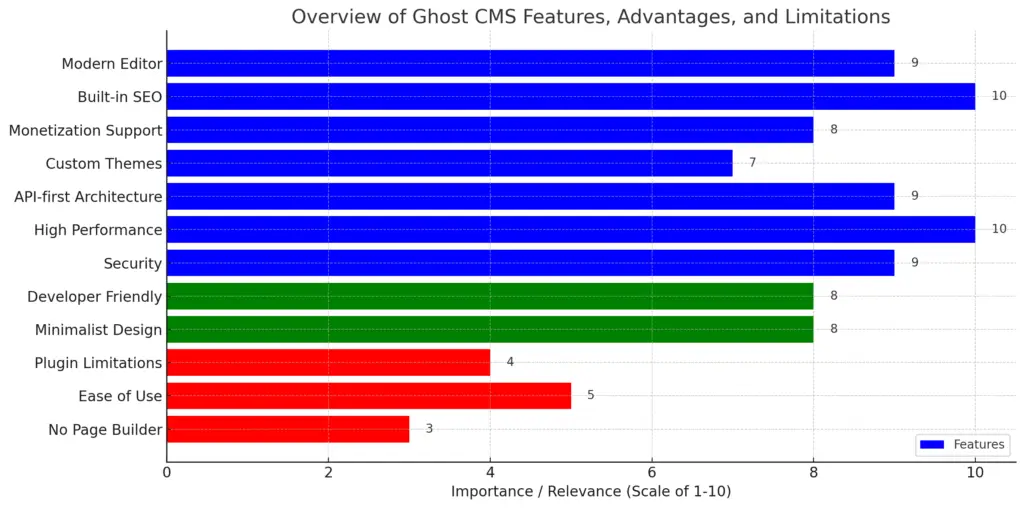Ghost CMS is open-source software that is made for professional publishers. In 2013, John O’Nolan started the project, which aimed to be simpler than WordPress. Ghost improves how writers organize and publish their work, so it is excellent for blogs, newsletters, and membership sites.
Based on Node.js, Ghost provides fast performance, high flexibility, and the ability to handle a lot of traffic. Its modern design allows using a headless CMS, which means you can deliver content from Ghost to several frontends through its extensive RESTful and GraphQL APIs.
Key Features of Ghost CMS
Ghost is special because it offers plenty of tools built to suit publishers and sites focused on content. These are some of the main features of the S-N framework:
1. Modern Editor
Ghost has a user-friendly Markdown editor with no clutter. It also makes use of “cards” so that images, embedded videos, call-to-action elements, and code sections can be inserted into the email.
2. Built-in SEO
All of the above SEO features, like automated XML sitemaps, canonical tags, structured data, and meta tags, come built-in with Ghost, so you don’t need any external plugins.
3. Support given via membership and subscription fees
Ghost is especially notable for enabling memberships and subscription charges right out of the box. Artists can accept money directly through Stripe after setting up their account on the platform.
4. Themes and how they can be changed
You can use the Handlebars templating engine with Ghost to add custom themes. It is flexible because developers and designers can integrate various external tools easily.
5. API-First Architecture
REST and GraphQL APIs are both available from Ghost because it is API-first. For this reason, React is good for developing with JAMStack and as a headless CMS.
6. Running Performance
Due to Node.js and its small core, Ghost is faster than most other traditional CMSs, especially WordPress.
7. Security
Ghost is set up with current security measures from the very beginning. Role-based access, content filtering, and regular updates help make sites secure.
Advantages of Using Ghost CMS
1. How quickly and effectively the business can operate
The entire architecture of Ghost is meant to be fast. Because of its modern technology and fewer heavy plugins, it delivers content more quickly than WordPress.
2. Minimalist Design
Its clean design and simple tools help writers and publishers concentrate on telling their stories, which is great for content creators.

3. Easy-to-use Monetization Features
Ghost incorporates membership and subscription directly into its system, which is not found in most other content management systems. Because of this, it becomes simpler for media businesses to rely on reader support.
4. Developer-Friendly
With Ghost, developers can do a lot of customizing. Thanks to being developed this way, you can use Drupal with many different extensions and tools.
5. Scalability
Running either a personal blog or a large online publication with Ghost is no problem. Ghost(Pro), installed on a server, is created to handle millions of views every month.
Limitations of Ghost CMS
Ghost also has a few disadvantages. Let’s have a look at some factors that can hinder language learning:
1. How easy will it be for someone who isn’t a software engineer to use this?
Even though the Ghost interface is easy to use, you need technical skills to install it on your server, mostly by using the command line and Node.js.
2. Developers can use fewer plugins
The plugin library for Ghost is not as large as WordPress’s. As a result, several features could require you to arrange custom coding or use third-party tools.
3. The page-building tools are not advanced
With Ghost, it is about the stories, not how they are displayed. You can’t create interactive web pages with a drag-and-drop builder, which some may find frustrating.
4. Hosting Considerations
When you self-host, you’ll have to buy a VPS such as DigitalOcean and take care of updates and backups-unless you buy Ghost(Pro), which automatically does it for you.
Use Cases for Ghost CMS
People or businesses that focus on content will find Ghost to be the most appropriate choice. Here are some usual applications of blockchain:
1. Personal Blogs
Banking on ease and efficiency, writers and creatives can have a great experience with Ghost’s Markdown editor.
2. Online Journalism
Digital publishing services let users handle authors, compile newsletters, and profit from subscriptions.
3. Business blogs in the SaaS sector
Ghost works well for budding companies and SaaS businesses that want a blog with powerful SEO to power their inbound marketing efforts.
4. Newsletters
Since Ghost has email support, sending newsletters and dividing your readers into groups is easy.

5. Headless CMS Project Examples
The JAMstack approach frequently has developers using Ghost to manage the content on their websites.

How to Get Started with Ghost CMS
Ghost can be set up in two main ways.
1. Ghost (Pro)
Anyone interested in computers can find this method very easy and direct. When you have Ghost(Pro), you get updates, better security, and assistance with problems right away. It is made so that people without computer programming knowledge can use it.
2. Self-Hosting Ghost
For people who are used to working with command-line tools, self-hosting gives them more control. Sign up for a VPS (such as DigitalOcean or Linode), then use the Ghost-CLI to install Ghost through the command line.
The following are a few steps to set up Ghost on your server.
- Download and set up Node.js, MySQL, and NGINX.
- Ghost-CLI can be used to install your new application.
- Purchase and set up the domain and SSL (Secure Sockets Layer) services as needed.
- Make changes to your theme and settings.
- Well-Known Ghost Themes and Integrations
Ghost is compatible with different themes that are both freemium and paid. Some top examples are:
- Dawn has a clean and simple design
- A responsive and well-designed theme is called Liebling
- Alto – A theme made for websites with loads of content
Popular Examples Are:
- Zapier – Set up automated tasks.
- Stripe is the place to handle billing for subscription services.
- Google Analytics – Check how well your website is working
- Mailgun – For handling email sending
- Disqus – Allow users to add comments
Is Ghost CMS Right for You?
Ghost is perfect for:
- Writers and bloggers who prefer minimalism
Publishers looking for built-in monetization tools
Developers building fast, API-driven applications
Organizations focused on speed and SEO
It might not be the best choice if:
You need advanced page builders or complex layouts
You want a large plugin ecosystem
You’re unfamiliar with server management and command-line tools
Conclusion
If you are looking for a modern alternative to standard CMS platforms, Ghost CMS would be a great candidate. Its focus on being fast, uncomplicated, and making money from content makes it a great site builder for writers, indie publishers, and developers.
Though it does not have all the tools new users want or need, Ghost is very fast, has strong SEO tools, and looks neat and clean. Building a blog or an online magazine? Whatever the case, Ghost gives you a solid, future-ready foundation.
Ghost CMS is the right choice if you want to focus on speed, simplicity,y and content.
FAQ’s
Yes, Ghost CMS can be used for free because it is open-source. You can host it for free on your own server. Nevertheless, some people may prefer managed hosting along with official help, and Ghost(Pro) offers this for $9 monthly.
It relies on the needs you have. Ghost is made for quick publishing, compared to WordPress, which has more features and a huge plugin library. If you are after a clear and writing-centered setup, you should consider using Ghost. If you want additional customization and e-commerce, you may benefit more from using WordPress.
Yes. You can move your website from WordPress to Ghost using the available tools and instructions, and this covers imports of posts, tags, images, and users. Custom features and plugins are not transferred and will need to be set up again manually, or another solution might be needed.
Not directly. Ghost is not created to handle eCommerce the same way WooCommerce is on WordPress. But you may connect third-party services like Shopify or Snipcart by placing their code or using their APIs when you want to.
As soon as you set up Ghost, it is highly search engine optimized on its own. It comes with meta tags, canonical URLs, structured data, AMP (Accelerated Mobile Pages), sitemaps, and clear HTML output, which you do not need plugins to use





